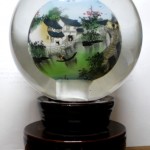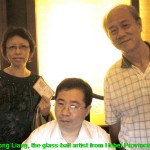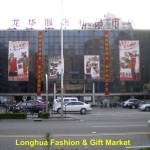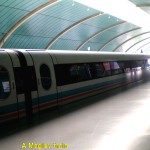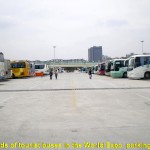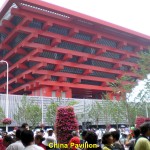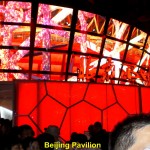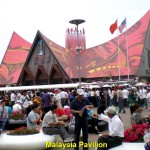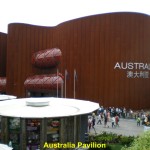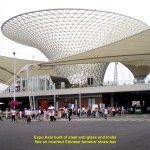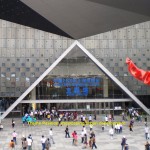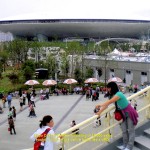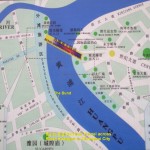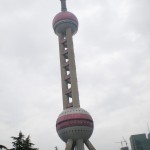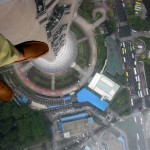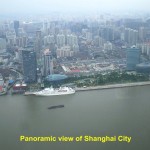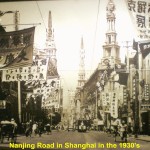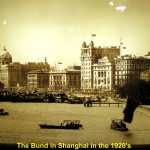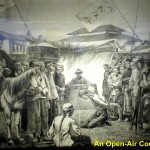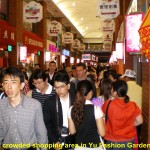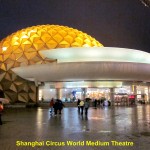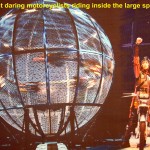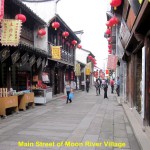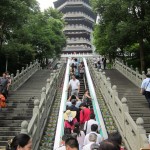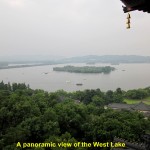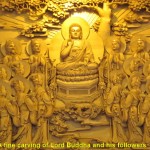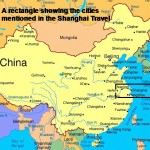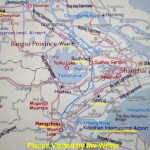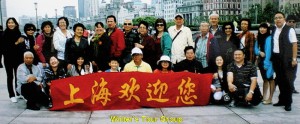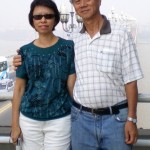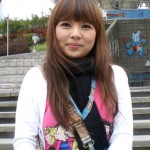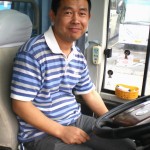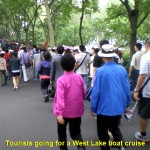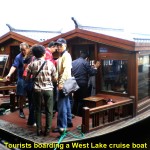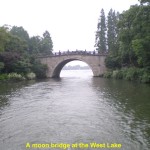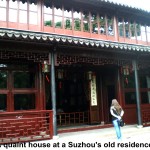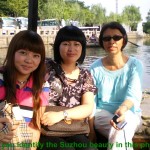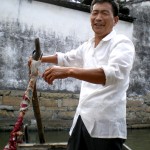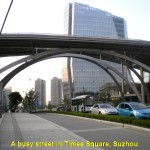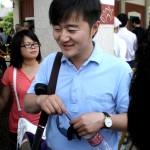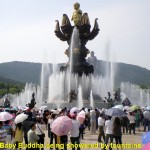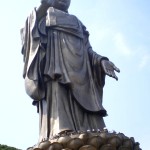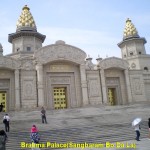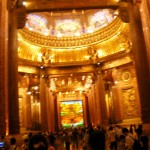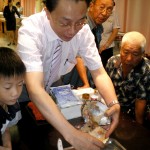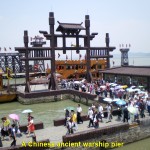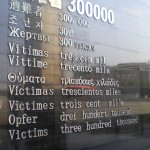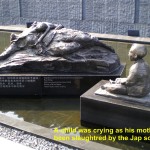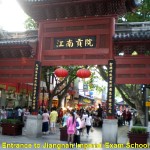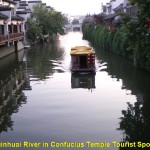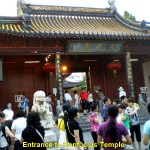Shanghai Travel II
(continued from Shanghai Travel I)
Shanghai Travel II
(Nanjing Bridge, Shanghai Expo 2010, Shanghai City)
Day 5 7 June 2010 (Monday)
In the morning, the first thing our Nanjing tour guide, Mr. Lee, wanted us to see was the China’s historic bridge, known as “Nanjing Yangtze River Bridge”.
Nanjing Yangtze River Bridge
It is a massive double-decker steel bridge with a highway on top and railway track below. Built in 1968 over the China’s second longest river, Yangtze River is 4,589 metres long. The Chinese are very proud of this bridge as it was built without any foreign assistance.
When we arrived at the bridge we took a lift to the top of a building that is beside it and watched a constant flow of vehicles on the upper deck of the bridge and, once, a train moving on the track below it. We also saw the scenery of the river, but it was spoiled by some mist in the area then.
Glass-Ball Paintings
Then we went down to a shop on the ground floor of the building to see unusual artworks: paintings inside glass balls. In the shop, glass-balls of different sizes with different Chinese paintings were displayed on shelves. They were mostly for sale, but they did not come cheap. Most of the paintings were done by a famous artist named Gong Liang and the rest by his students. We were told by our Nanjing tour guide, Mr. Lee, that the artist was very generous as he would donate most of his sale proceeds for the repair and maintenance of the grand bridge, the Nanjing Yangtze River Bridge. When my wife bought one of his art pieces, both of us had the honour of taking a photo with him. Unfortunately, the photo turned out to be dark, as we were told to take the photograph without flash that might damage the artist’s valuable eyes. Anyway, with digital technology, the photo is edited and can be seen clearly as shown here.
Shanghai City
At 2.30 p.m. we left the bridge and began a long journey to China’s largest city, Shanghai. It would take us four hours to reach the metropolitan.
Shanghai has a population of about 20 millions. Located at the estuary of Yangtze River, it was founded by the Song Dynasty(969-1279 A.D.) and became a thriving trading port in the 17th. Century. It has a colourful history, and rich eastern and western cultures. Now, it is the largest financial, commercial, trading and tourist centre in China.
Longhua Fashion & Gift Market, Shanghai
When we arrived at the vibrant city of Shanghai, the first place we visited was an old shopping mall known as Longhua Fashion Gift Market. At the entrance of the mall, we were surprised to read a government notice which warned shopkeepers not to sell fake goods with branded names. When we went round the mall we were surprised that none of the goods had branded names. The good shopkeepers had abided with the request in the notice.
As it was Monday when we visited the mall, there were very few visitors and many shops were closed. After spending less than an hour there, we left for dinner at a restaurant and then we checked in at a hotel known as Shanghai Airlines Travel Hotel.
Day 6 8 June 2010 (Tuesday)
Shanghai Maglev Train
In the morning, we went to Shanghai Pudung International Airport to have a high speed experience on a Shanghai Maglev Train. It is the only magnetic levitation train in China. In 2004, it began its operation running a distance of 30.5 km in about 8 minutes from the airport to Lonyang Road Station in the outskirt of Shanghai City. Its top speed is 431 km/h. We enjoyed the ride as it was smooth, fast and quiet; unlike the conventional train which is noisy, jumpy, jerky and slow. In future, China is going to build long distance tracks for Maglev trains linking all its major cities.
World Expo 2010, Shanghai City
At 12 noon, we went to a Huangpu River waterfront near the Lupu Bridge in Shanghai to see the World Expo 2010 which commenced on the 1stof May and will end on 31st. October 2010. Held with the theme “Better City, Better Life”, it is the largest exhibition in the world with over two hundred foreign participants and expects a total of 70 million visitors.
On arrival at the Expo site, we were surprised to see hundreds of tourist buses parked, neatly, in a large open space. We were delighted that we did not have to queue up for a long time to enter the Expo site as it was already 12.30 in the afternoon.
China Pavilion
While we were in the Expo area, we were amazed to see lots of visitors everywhere. Our chief tour guide, Mr. Chu, told us that the average daily number of visitors at the Expo is about 300,000. He led us to the China Pavilion. It was a long walk to the large, red building which looks like an inverted pyramid.
As we were walking to the building, Mr. Chu told us that the tickets for the exhibition in the main hall of the China Pavilion were already sold out a few months ago, but he asked us to join a very long zigzag queue to another hall adjacent to the main one. The admission for that exhibition was free.
Mini-Pavilions
After more than 30 minutes of queuing up, we, finally, entered the hall. It was a very large hall where there were many mini-pavilions close to each other. Each mini-pavilion was represented by a province of China boasting of its rich histories, cultures, ethnic peoples, economies, scenic landscapes, etc. Owing to time constraint, we made a quick tour of all the mini-pavilions. When we came out of the hall, we felt as though we had visited all the provinces in China.
Long Queues
While we were outside the China Pavilion we were shocked to hear announcements after announcements that the queuing time at Japan’s Pavilion was then 5 hours, Italy’s 3 hours, Germany’s 2 hours, USA’s 3 hours, and so on. That discouraged my wife
and I from going near those pavilions. So, we walked along a long elevated walkway that cut across the Expo site in the middle and felt contented looking at the pavilions of different shapes and sizes; some were nearby while others far away.
Malaysia Pavilion
Then in the late afternoon, we decided to visit our own country’s pavilion, Malaysia Pavilion. Fortunately, the queue was short when we arrived there. As the queue was moving slowly, we were occasionally pushed roughly by impatient visitors behind us and a few uncivil ones jumped queue. After 23 minutes of lining up, we, happily, entered the pavilion. There were quite a lot of exhibits inside that showed some Malaysian places of interest, racial, religious and cultural diversities, a variety of economies, arts and crafts, etc. We were glad that our Malaysian pavilion had put up an impressive exhibition.
Visiting Other Pavilions
Then we went to look for pavilions that had short queues. We managed to enter three more pavilions belonging to Brunei, Cambodia and New Zealand without much waiting. By the time we visited the last one, it was time to leave the Expo site. While leaving the place, we felt disappointed for not being to visit the popular ones such as Japan, USA, Italy, and Britain.
When the World Expo 2010 in Shanghai is over, it is sad that all the pavilions costing tens of millions of dollars each, except the China Pavilion, Expo Axis, Expo Culture Centre, Expo Centre and Theme Pavilion., will be torn down.
A Lost Tour Member
At 7 p.m. we went back to our bus outside the Expo site. But we could not go for dinner, immediately, in the downtown as one of our tour members did not turn up yet. Our chief tour guide, Mr.. Chu, and tour group leader, Miss Ng, walked back to the Expo site and searched for him, frantically. An hour later, we all heaved a sigh of relief when we were told that he was found waiting at the wrong place. When he came back and joined us on the bus, he apologized to us, profusely, for causing the delay.
Golden Jaguar Plaza Restaurant
For the late dinner, we went to a large restaurant, Golden Jaguar Plaza Restaurant, and had a buffet-style dinner. It provided over 200 kinds of food and we, happily, savored many of them. After that sumptuous meal, we went back to our hotel and slept like a log.
Day 7 9 June 2010 (Wednesday)
After breakfast, we visited a Chinese medical shop selling Baoshutang medicines which it claimed to have remedies for many body ailments, including eczemas(skin problems), arthritis, sprain, muscular ache, insect-bites and rheumatism. Then, we went to the most popular tourist spot in Shanghai City, The Bund.
The Bund, Shanghai City
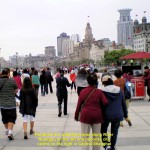
The Bund is a waterfront between River Huangpu on the left and historic city centre in Puxi on the right
The Bund, in the city centre, is a stretch of embanked waterfront along the Huangpu River. At this place, a visitor can see a row of grand, old colonial buildings along Zhongshan Road(E-1) and skyscrapers of modern architecture in the financial centre, Lujiazui, across the Huangpu River. We spent an hour enjoying the breathtaking sceneries and the refreshing air from the sea at the Bund. Then we left the place and went underground to take a small cable car which passes through a tunnel under the Huangpu River to the other side of the river. The tunnel known as the Bund Tourist Tunnel is 647 metres long and was opened in 2000.
The Oriental Pearl Tower
Having reached the other side of the river in a few minutes, we went straight to Shanghai’s iconic landmark, the Oriental Pearl Tower. Standing 468 metres high at the crossroads of Fenghe Road and Lujiazui Road, it is the highest TV tower in Asia and 3rd. in the world. It is a tourist attraction and allows tourists to go up as high as 350 metres to get a spectacular 360 degree-view of the Shanghai City.
When we went up the tower the first place we went to was the revolving restaurant at the height of 267 metres. As we were having lunch at the restaurant, we could see the outside scenery that, seemingly, moved and felt as though we were on top of the world. After the meal, we went down to the lower floor which was 259 metres high. Standing on the circular floor which was made of glass, we could see part of the city just below our feet and also other parts through a glass-wall surrounding the floor; everything down there seemed small, like toys.
It was an unforgettable experience to view the city from such a height. As we were walking on the circular glass-floor that had a circumference of 159 metres we noticed that some tourists were afraid to step on it while others were very excited asking their friends to take their photos.
Shanghai’s Urban History and Development Museum or Wax Museum
After that exciting height experience we went down to the ground floor and entered a museum that is known as Shanghai’s Urban History and Development Museum or commonly known as the Shanghai’s Wax Museum. It has over 1,000 exhibits, including 100 live-like wax figures, related to the past history and development of the urban Shanghai. In the museum, we visited five halls of different themes, like the old city transportation, the old city scenes of economic activities, the city’s architectural landscapes in the 20th. Century, the activities of foreigners who lived in the city, the city lives of the Chinese, etc. It took me quite awhile to learn a lot about the interesting past history of Shanghai City in the museum.
Yu Fashion Garden(Yuyuan Market)
Next, we went to a famous large shopping area known as Chenghuangmiao Shopping Centre, City God Temple Shopping Centre, Yu Fashion Garden or, commonly, known as Yuyuan Market in the old city of Shanghai. It was believed that a temple was built in this area for the local people to worship a god whom they thought could protect and gave them good harvests, annually. As there were lots of worshippers going to the temple, especially, on festive days, many shops were built near it to cater for their needs. Recently, all those old shops were torn down and new, large, beautiful ones that look like an ancient Chinese temple were built. The old temple was also rebuilt for the worshippers.
This place, Yuyuan Market, is now a popular tourist shopping centre where shops sell all kinds of merchandise, ranging from food and beverages to bags, clothes, electrical goods and jewellery. While we were there busy shopping and admiring the architectural structures of the buildings, it was raining. But the rain did not deter more tourists from going to the place.
Shanghai Circus World
In the evening, after dinner, we went to the Shanghai Circus World to watch a show called “ERA: Intersection of Time“. This show amazed us as the young, energetic performers did a lot of brave stunts that kept us excited but nervous , sometimes. The most daring stunt that kept us on edge all the time was the grand finale of the show: a motorcycle stunt. In the stunt, motorcyclists rode their machines round and round inside a large sphere made of metal strips. At first, a motorcycle entered the sphere and went round and round inside, then followed by another, later, another, then another, and finally a total of 8 motorcycles moving in two separate circles inside, continuously. That was an extreme spectacle and everybody applauded loudly. When the stunt ended, all the motorcyclists came out of the sphere, one at a time, and stopped in the centre of the ring. When they took off their crash-helmets we were surprised to see two of them who were ladies.
Xintiandi
After that exciting show, we went to an interesting place known as Xintiandi (or “New Heaven and Earth”). It is a place where small, quaint colonial buildings with narrow walkways, offer merchandise, food, beverages and entertainment which are a bit pricey. It is a romantic place in the evening as the place is dimly-lit. Because of its mixed setting of Chinese and European in an old place, it attracts many tourists. We spent a short time there as it was raining. Then we left the place for our hotel.
Day 8 10 June Thursday 2010 (Thursday)
Moon River Town, Jiaxing
This was the last day of our tour. In the morning, we left Shanghai City for Hangzhou City which is a few hours away by bus. On the way, we stopped at an old water town which is a tourist attraction in Jiaxing. Known as Moon River Town, it has canals and rivers along which ancient houses have been built, like the old water town we have visited in Suzhou City. Its narrow roads and walkways are built of large bricks. Most of these buildings are shops that sell souvenirs, antiques, medicines, food, drinks, clothes, flowers, arts and crafts. We had our lunch in a restaurant there.
Leifeng Pagoda in the Evening Glow
Later, we left the Moon River Town and continued our journey to Hangzhou City. Before reaching the city, we stopped at another place known as Tongxiang Tongxin Food Co., Ltd. in Tongxiang City where we bought some young dry chrysanthemum flowers which the producer claimed had health benefits. Then we moved on and finally reached the city in the late afternoon. On arrival we went to our last place of interest. It is a well-known pagoda called Leifeng Pagoda in the Evening Glow.
Erection of the Pagoda
Originally, a pagoda was built on a small hill, Sunset Hill, which is in the south of the West Lake, in 977 A.D. to keep the Lord Buddha’s hair coated with silver and gold. According to another version, the pagoda was erected by Qian Hongchu, who was the king of the Kingdom of Wu and Yue, to celebrate the birth of his son by his favourite concubine named Huang.
It had been damaged, repaired, burnt down and rebuilt many times. In 1924 it collapsed due to a long period of neglect. Then in 2002, a new, beautiful, magnificent and elegant pagoda was built on the original site. It is five storeys high (about 72 metres), octagonal in shape and built mostly of steel and copper. It has two lifts in the middle that bring visitors to the top four levels for viewing the scenic West Lake and the mountainous areas.
Inside the Pagoda
On the ground floor of the pagoda, visitors can still see the remains of the base of the old pagoda. At other levels above, there are paintings and carvings depicting the life of Lord Buddha and the legend about the immortal Lady White Snake, and the writings and paintings about the old pagoda and an emperor‘s visit to the pagoda. Besides, at one level, there are three-dimensional pictures of the West Lake sceneries a visitor may see outside the pagoda if he is on a viewing deck.
In the evening when the sun is setting, the shadow of the pagoda together with the colours of the sky in the reflection at the lake make the pagoda seem to be glowing, thus it is known as Leifeng Pagoda in the Evening Glow.
Leifeng Pagoda Visit
When we arrived at the foot of the Sunset Hill, we saw lots of visitors going up the hill to the pagoda by elevators instead of climbing up the steps. Then we followed them and reached the base of the Leifeng Pagoda. Standing right in front of the pagoda and looking up, we were astounded to see the large, towering pagoda. When we entered the pagoda, we saw the remains of the old pagoda base. Later, we went up by lift to all the levels to see the paintings and carvings on the wall, and the panoramic views of the scenic West Lake, Hangzhou City and the mountainous areas which were spectacular.
Ba Gua Bu Yi Cuisine Restaurant, Hangzhou City
Then we left the pagoda to have dinner in a restaurant known as Ba Gua Bu Yi Cuisine Restaurant in the Hangzhou City. When we had finished the meal we were entertained by a big man in a heavy Chinese traditional costume. He was wearing many masks. As a Chinese song was played, loudly, he danced on a small stage and changed his masks one at a time fast. He was an amazing performer, as he could change more than ten different masks in one song.
“Night of West Lake“ Show
After enjoying the one-man show, we left for a theatre, Dongbo Theatre, to watch a splendid and spectacular Chinese cultural show known as “Night of West Lake“. It was an extravaganza that had five parts: “King Yue’s Power”, “Prosperity of Qiantang”, “Butterfly Lovers”, “Elegance of Qiantang”, and “Oriental Buddhism”. We enjoyed the show very much as it mesmerized us from the beginning to the end.
Journey Back to Malaysia
After the show, it was time to go back home in Malaysia. So, we headed for the Hangzhou Xiaoshan International Airport. On arrival, our chief tour quide, Mr. Chu, did a wonderful thing for all of us. As he knew that some pieces of our luggage were overweighed and the airline company would charge for the excess luggage weight, he combined the heavier ones with the lighter ones from different persons so that the combined weights did not exceed the weight limit. His ingenious method saved some of us some money.
Finally, we all thanked and bade farewell to our wonderful, helpful and diligent chief tour guide, Mr. Chu, and super bus-driver, Mr. Su.
At 11.20 p.m., we left China for our country, Malaysia, bringing along with us fond memories of the tour and our tour guides, too.
Acknowledgement:
We would like to thank the tour agency, Chiu Travel Sdn. Bhd., Batu Pahat, for organizing the above-mentioned, unforgettable tour for us and its employee, Miss Ng, for looking after us all the time during the tour. Here, we would like to thank Mr. Chu, our tour guide leader, and Mr. Su, our bus driver again for rendering us excellent service during the tour. Last but not least, we would like to thank our three assistant tour guides who had also done a good job: Madam Chien(our Suzhou tour guide), Mr. Chiang(our Wuxi tour guide) and Mr. Lee(our Nanjing tour guide).
Thanks to you too for taking the trouble to read my travel above.
I hope the information given above is useful to those who plan to visit the China cities in future.
The End
Written by Choo Chaw of Kluang, Johor, Malaysia.
Shanghai Travel I
Shanghai Travel I
(Please click on the images below to view large complete ones)
My wife and I have been to the north-east and south-east China. So, in March 2010, we planned to visit a few
tourist destinations in the middle of the eastern coast of China, viz. Hangzhou, Suzhou, Wuxi, Nanjing, Xiaxing and Shanghai. Then we called up our favourite tour agency, Chiu Travel Sdn. Bhd. in Batu Bahat, Johor, Malaysia and booked an 8-day package tour. The tour would be from 3 to 11 June 2010. Below is the dairy of our memorable visit to the historical, cultural and developed cities and their scenic landscape sites.
Travel to Hangzhou
Day 1 3 June 2010 (Thursday)
My wife and I joined a group of 22 people for the tour(see photo above). We were all brought by the tour agency’s bus to KLIA in Sepang from Johor- a 3-hour journey. The agency sent a young, pretty and sweet lady, Miss Ng, to be our tour group leader taking care of us all. On arrival at the airport, we went through the normal procedures: checking-in, security checking, immigration passport stamping and waiting to board the airplane.
At 5.20 in the evening, we left the Malaysian airport by an Air Asia plane. Five hours later, we landed safely at the Hangzhou Xiaoshan International Airport in China where we were greeted by a young prosperous-looking guy, Mr. Chu, who would be with us for the entire 8-day China tour. He would take care of our meals and hotel accommodation, besides conducting the guided tour.
After introducing himself as our chief tour guide, Mr. Chu brought us outside the airport to board a China tour bus. The bus-driver was Mr. Su who was friendly, but a man of few words. He had 17 years of driving experience. Then Mr. Su brought us to a
restaurant in Hangzhou City of 6.7 million people to have a very late dinner before we checked in at a comfortable hotel nearby. It had an unusual name: Day Joy Refinement Hotel.
Day 2 4 June 2010 (Friday)
The Scenic West Lake, Hangzhou
At 9 in the morning, we left the hotel to begin our China tour. Our first visit was the West Lake in the Hangzhou City. When we arrived there, we were amazed to see lots of tourists walking to a pier to board cruise boats. The boats would take them across the lake for sightseeing.
Arriving at the pier, we boarded an electric-powered wooden boat and crossed the scenic West Lake, slowly. As it was moving, we could see three islets in the middle, Hangzhou City in the east and mountainous areas in the north, west and south. Besides, we saw three small stone pagodas of 2 m high standing in the water near the largest islet. They were made in 1621. During the full moon, a candle is placed in a hole in each of the pagodas and its light will mingle with the moonlight in the water. Thus, they are known as “Three Pools Mirroring the Moon”.
Meijiawu Village
After the 30-minute relaxing boat-ride, we left for a famous green tea plantation in Meijiawu Village in a hilly area west of Hangzhou City. This village has a history of 600 years of green tea-making. It produces four types of tea, but the most popular one is known as “West Lake Dragon Well” green tea. It has a strong, pleasant smell and refreshing taste.
Many foreign dignitaries have visited this well-known tea village, like Queen Elizabeth II, the Princess of Thailand and the former President of Soviet Union, Voroshilov. Besides, it has attracted the leaders of China, such as the former Chinese Premier, Zhou En Lai, and former Chinese President, Jiang Zemin.
We spent an hour at a green tea shop in Meijiawu Village learning about tea-making, the benefits of drinking tea, tasting the tea and admiring the scenery of the hills covered with tea plants. Later, we headed for Suzhou City.
Classical Gardens(Residences)in Suzhou Water Town
Suzhou City is about 90 km west of Shanghai. Near this city is a water town. It has canals and arch bridges, like Venice in Italy, and some classical gardens(residences) with many quaint houses along the canals. The latter have historical, cultural, architectural and landscape significance. Only the elite could afford to buy and stay at these gardens in the olden days.
When we arrived there we met aa experienced Suzhou tour guide, Madam Chien. She brought us to see one of the gardens(residences) known as “The Garden of Couple’s Retreat”.
“The Garden of Couple’s Retreat”
Located on the north-eastern edge of the ancient Suzhou City, the Garden of Couple’s Retreat occupies an area of 0.8 hectare. It is surrounded by a tall wall with an entrance in front and a backdoor which leads to a platform by a canal. There are some buildings in the garden which look quaint, elegant and unique in architecture. They are all linked to each other by corridors. In a small area of the garden there is a rock garden mountain and a small summer house by a small pond nearby.
The garden was built in the early Qing dynasty as a pleasure garden of Baoning Prefect, Lu Jing Zhi. Then in 1874 A.D. a governor, Shen Bing Cheng, lived there with his wife when he retired. He named the garden as “The Garden of Couple’s Retreat”. In 1941, a Changzhou industrialist, Liu Guojun, acquired it and spent several years renovating it. In 1955, he donated the garden to the Suzhou Municipal government. Later, the government renovated and opened it to the public to learn about the life-style of the elite in the olden days.
After a tour of the garden, we left by the backdoor and boarded a small boat for a short ride. As an elderly man was rowing the boat down a canal he sang us an old Suzhou love song with much feelings. Soon, we left the place and went to another place known as Times Square.
Suzhou Times Square
Located in the east of the Jinji Lake, Times Square is a large commercial complex which will become Suzhou’s central business district(CBD) soon. When we were at that place we saw the world’s longest LED screen known as West Harmony Sky Screen. It is 500 metres long and 32 metres wide; 100 metres longer than the one in Las Vegas(USA). Unfortunately, after dinner at a restaurant there, we had to leave the place before 7 p.m. So, we felt disappointed for not being able to watch the LED screen at night. Arriving at the Suzhou downtown, we stayed at a hotel known as Lidu Hotel in Suzhou City.
Day 3 5 June 2010 ( Saturday)
Kaidi Silk Factory, Suzhou
As Suzhou has been famous for silk since hundreds of years ago, our tour guide, Madam Chien, brought us to a well-known silk factory, Kaidi Silk Factory, in the morning. When we entered the factory we were surprised to see a lot of tourists. In the factory, we watched machines unwinding silk thread from oval-shaped, white cocoons, workers stretching cocoons into flat pieces and other workers making quilts from those pieces.
After watching those interesting activities, we were led to a room where silk products were on sale. We noticed that the factory was doing a brisk business as many tourists were buying its silk products, such as quilts, silk pillows and silk clothes; thanks to their tour guides who were helping the factory to push its sales. We, too, were convinced by our tour guide, Madam Chien, to buy them. Later, we watched a short fashion show in another room. In the show, pretty Chinese models showed off the factory’s silk dresses as they were walking down a catwalk.
Lingshan Buddhist Scenic Spot , Wuxi
Before we left for another city, Wuxi, we thanked Madam Chien and bade her farewell. When we arrived at Wuxi City, we were greeted by another tour guide, Mr. Chiang, a young handsome guy who had 8 years of experience working as a guide. He brought us to see the World’s tallest standing Grand Buddha statue located on a small mountain, Lingshan, which is 10 km south-west of Wuxi City and near the shore of Taihu Lake(the 3rd. largest freshwater lake in China). Standing 88 metres high, it is made of bronze.
When we arrived at the Wuxi Lingshan Buddhist Scenic Spot where the statue is, we were astounded to see many beautiful new buildings in different parts of the large area. Fortunately, there were many 14-seater cars around to carry tourists to all the places there. As there were many tourists on that Sunday, they had to queue up for the cars to bring them to the places they wanted.
Our tour group took the cars and headed for the Grand Buddha site. When we reached there we saw a statue that was huge, tall and majestic standing on a small mountain. It is known as Grand Buddha. Some of us climbed up a few hundred steps to reach Him to get a closer look. While we were on the high ground, we saw a breathtaking view of the land below which is flat and stretching a few hundred metres to the shore of the Taihu Lake. After a few photo-shoots there, we went to another spot by cars again to see the Baby Buddha statue on a high pedestal.
Baby Buddha
When we reached there we heard a band playing music, loudly, and saw many tourists crowding around a high pedestal. A few minutes later, the fountains round the pedestal were shooting water into the air and showering a large closed lotus flower-shaped structure atop the pedestal. As the flower was opening, slowly, a golden statue of the Baby Buddha was revealed. It was showered by the fountains, at regular intervals. Thus, the spot is called “Nine Dragon Fountains Bathe Siddhartha Gautama(Lord Buddha)”. When the music ended the baby was in the closed lotus flower again and the crowd dispersed.
Sangharam Bo Da La (Brahma Palace)
After that solemn but symbolic show, we joined a long queue for cars to take us to another place which was Sangharam Bo Da La (Brahma Palace). Brahma Palace is a beautiful building that houses sculptures, ornate carvings, paintings and murals that depict the life of Lord Buddha and the spread of Buddhism in China. On the back wall of the hall is a large piece of colourful glazed work known as Avatamsaka World, which has a figure of Lord Buddha in the centre. As the figure is made of gold it is heavily guarded. In the middle of the hall, there is a dome above with wood carvings depicting the life of Lord Buddha.
Before entering the hall, we were given a pair of cloth-shoes to wear over our own shoes. This was to prevent our shoes damaging the floor of the hall. While we were inside the hall we were awe-stricken by all the things that we saw. After spending an hour appreciating the exhibits and learning about Lord Buddha in the hall, we left the Lingshan Buddhist Scenic Spot and headed back for Wuxi City. After dinner at a restaurant we checked in at a hotel known as Milido Hotel in the city.
Day 4 6 June 2010 (Sunday)
A Pearl Factory in Wuxi
In the morning, our Wuxi tourist guide, Mr. Chiang, asked us to visit a well-known pearl factory. When we were there the kind owner opened a large cultured freshwater oyster and showed us its small pearls inside. He told us that small pearls were ground into powder and mixed with a cream that was used for getting rid of blemishes on our faces and bodies, whereas large pearls were used for making jewellery. Then he invited us to see his products and asked us to buy them if we were interested.
The Three Kingdom City, Wuxi
Having spent an hour at the pearl factory, we moved on to a renowned place, The Three Kingdom City. Located in the south-west of Wuxi City and on the northern lakeside of Taihu Lake, it was built by CCTV in 1993 for the purpose of shooting the TV series known as “The Romance of the Three Kingdoms”. The three kingdoms refer to Wei(220-265), Shu(221-263) and Wu(229-280) which were in constant conflict among themselves. To shoot the TV series, CCTV built many Han Dynasty-style buildings including King Wu Palace and Nectar Temple, Caocao’s Army Camp, 7-star altar, signal fire platform, ancient warships and horse battlefield in a total area of 35 hectares. Subsequently, other TV series and movies based on ancient Chinese histories were shot there. (Han Dynasty ruled from 206 B.C. until 220 A.D.)
Besides being a shooting location for TV series and movies, just like the Universal Studios in Hollywood, The Three Kingdom City site has become a popular tourist attraction.
In The Three Kingdom City, we marvelled at the beauty of the buildings, enjoyed the sights of the landscape and had short ride in an “ancient” Chinese warship in the Taihu Lake. We were fortunate to watch an ancient dancing concert performed by young and energetic performers in a crowded building(“Nectar Temple“). At 12.30 p.m. we left the place and travelled north-west to Nanjing. It took us about three hours to reach there.
Nanjing War Memorial Museum
On arrival at Nanjing City of 6 million people, we headed straight to the War Memorial Museum. At the museum we were greeted by a Nanjing tour guide, Mr. Lee, a serious-looking gentleman. As we were walking in the War Memorial compound, we saw sculptures of war victims in various states of sufferings and death. We also saw a 12-metre high cross showing the period of the massacre, carvings on a long high wall depicting the massacre, many memorial stones commemorating the victims killed in different parts of Nanjing, stone covered ground where some victims were believed to have been buried, a black wall with shocking words “Victims: three hundred thousands” written in 10 languages, and a large statue of a Nanjing woman who was a victim.
“The Pit of the 10,000 corpses”
Mr. Lee with a solemn face told us how the 300,000 innocent civilians and unarmed soldiers in Nanjing were slaughtered for six consecutive weeks by the Japanese invaders in 1937 and where the mass graves were. When he brought us inside a building we were shocked to see a lot of human bones lying in an exposed mass graveyard under spotlights. He told us that 9,721 dead bodies were buried there, thus the place is known as “The Pit of the 10,000 corpses”. It was a grim and depressing sight to all of us. Besides, it gave us the shivers when we thought of war atrocities. (This place is not for the faint-hearted as it had affected some of our tour members later.)
“The Peace Park”
Then Mr. Lee led us out of the inferno to an open-air area known as “The Peace Park”. Located at this park is a statue of a woman standing on a high pedestal of over 25 metres. She is releasing a dove in one hand and carrying a child in the other, seemingly, appealing to the whole world to live in peace. Finally, we left the museum with deep sympathy and sadness for the war victims. Some of us might leave the place with an indelible memory of the horrific WWII event in the Nanjing dark history.
Fujimiao(Confucius Temple) and Qinhuai Scenic Spot
After an early dinner, we went to a popular shopping and cultural area known as Fujimiao(Confucius Temple) and Qinhuai Scenic Spot which is along the Qinhuai River in south Nanjing City. This place has been a popular tourist destination for a long time.
Jiangnan Examination Hall
At this place, there are two significant large buildings that have been built in ancient Chinese architectural styles to replace the old ones. They both have cultural and historical significance. They are the Jiangnan Examination Hall and the Confucius Temple. Originally, the former was built in 1168 as a county and prefecture examination centre. Later, when Nanjing became the capital of the Ming Dynasty, it became a centre for province and imperial exams. But, when the capital was moved to Beijing in 1421, it carried out the county exams only. The centre had produced many famous scholars in the olden days. The present building was built in 1989 to replace the old one.
Fujimiao Temple(Confucius Temple)
The Fujiamiao Temple or Confucius Temple was first built in 1034 to commemorate the great thinker and educator, Confucius. Devotees from near and far came to the temple to worship the sage. It had been damaged, set on fire and repaired several times. Then it was rebuilt in 1984 and completed in 1985.
Many old buildings around them had been pulled down to make way for new ones. Most of these are now shops selling goods ranging from food and beverages to clothes and handphones.
Qinhuai River Attraction
Another attraction in this area is the Qinhuai River. It is 110 km long and a branch of the Yangtze River, passing through the city of Nanjing. In the olden days, it was an important means of transport. Tourists now can take a boat cruise along this river to see ancient buildings, old gardens and bridges.
Walking in the Fujimiao tourist area, seemingly, brought us back to the olden days when the place was crowded with people who were visitors, traders, devotees and scholars. We spent an hour or so at the busy place, before we stayed at a hotel known as Jihua Garden Hotel in the downtown.
(continued in Shanghai Travel II)


